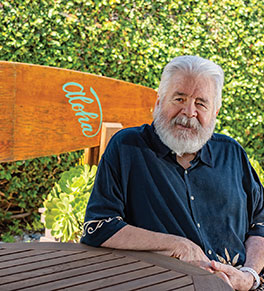Treating chronic pain without drugs

Longtime surfer and hot-rod enthusiast Mike Kilfoy found relief from crippling shoulder pain with a new peripheral nerve stimulation device.
Photo by Kristin Anderson
Chronic pain afflicts one in three Americans, according to the U.S. Institute of Medicine, a number that is multiplying as the population ages.
People try biofeedback, meditation, physical therapy and other alternatives to surgery surgery and drugs for pain relief.
Ultimately many still require some form of prescription pain medication. In 2017, opioid prescriptions were written for almost 58 in every 100 Americans. The same year, an estimated 1.7 million people suffered from disorders related to opioid prescriptions.
But pain management specialists had little to offer. Until now.
Resetting nerve pain
”We are entering a new frontier with a minimally invasive, non-permanent medical device that has the potential to reset nerve pain,” says UCI Health pain management expert Dr. Shalini Shah, who leads the UCI Health Center for Pain and Wellness.
The pain center in Irvine is now the first in the region to offer peripheral nerve stimulation (PNS), which has been shown to relieve chronic pain a year or more.
Shah — an ever-cautious scientist — is willing to call the SPRINT PNS device “a major breakthrough” in drug-free, surgery-free pain management. “It’s a relatively young technology so we’re still looking at longer-term outcomes, but right now I’m very excited.”
It has been a god-send for Mike Kilfoy, who received PNS treatment on both shoulders at the pain center. The Costa Mesa man had rejected orthopedic surgery on his left shoulder because of the difficulty he'd had a decade earlier recovering from not one but two rotator cuff surgeries on his right shoulder.
“The pain I went through then to recover wouldn’t be worth it now, based on the amount of improvement I received,” says Kilfoy, who is 74 and has other health concerns these days — he battles Parkinson’s disease and diabetes.
Opioids to relieve pain
Prescription painkillers seemed to be his only option to reduce the severe shoulder pain. Kilfoy started with one or two Vicodin, a prescription opioid, each day.
Six months later, he sometimes needed three or four pills to bring his shoulder pain down to a bearable level.
When tests showed the drugs were likely causing a rise in his liver enzymes, his doctor referred him to UCI Health pain center.
Finding the pain source
At a second office visit, the hair-thin nerve stimulation device is implanted through the skin. It takes about 30 minutes to place and program the device’s energy settings.
The patient then goes home with a small battery-operated remote to control the amount of stimulation sent to the nerve to quell the pain.
After 60 days, the device is removed. Data shows that about 75% of patients can have sustained pain relief for 12 months or even longer, Shah says.
Almost pain free
Indeed, after treatment, Kilfoy’s left shoulder is almost pain-free. He recently finished the 60-day treatment on his right shoulder and is seeing equal success so far.
The results have been a huge relief to Kilfoy’s wife because Parkinson’s has reduced his mobility.
“It’s really hard to watch someone in pain and not be able to do anything to help,” says Mary Kilfoy, who is his primary caregiver.
Now, she says, her husband can comfortably read, watch television, putter around their yard and enjoy weekly visits with their daughter. “This has been amazing.”
At one point in his life, Kilfoy headed up two companies. He surfed, drove hot rods and rebuilt them. And he traveled. Parkinson’s took away his ability to enjoy activities, says Mary, but not his adventurous spirit.
“SPRINT is a newer procedure, and some people may be hesitant to try anything new," she says. "Not Mike. He is always up for doing something new, especially if there’s a chance that he can help other people by trying it.”
And if the pain returns in a year, he says he's game to try it again.
Long-term relief studied
Shah says the device also has been shown to provide relief for pain in the knees, low back and pelvic area, as well as post-amputation pain. The treatment, which has been approved by the U.S. Food and Drug Administration, is now covered by Medicare and major insurers.
Shah, meanwhile, is tracking patient outcomes and looks forward to publishing long-term results on the safety and effectiveness of SPRINT PNS to relieve acute and chronic pain.
“For many patients, conservative options such as medications and physical therapy are still the mainstay," she says.
“However, the future looks bright with technology like peripheral nerve stimulation for patients who want to avoid drugs and have a reliable way to relieve their pain.”




